A Quick Tour

| This program uses the left mouse
button exclusively
|
After launching the curve system you should see the following two windows:
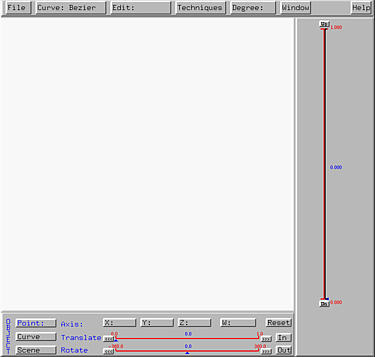
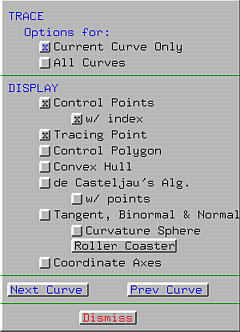
The left one is the drawing canvas on which you design your curve.
The right one is the Display & Options Window, which contains various
display options.
Exiting the Program
To exit this program, select
File followed by
Exit.
Creating Control Points
The drawing canvas is the xy-plane with the x-axis running
from left to right and the y-axis running from bottom up.
The coordinate origin is at the center of the drawing canvas.
The first step of designing a curve is putting some control points on the
drawing canvas, the big square area. This requires the
following steps:
- Select Edit followed by
Create. The pointer
changes to a cross indicating that the program is
in the insert mode.
- Move the pointer to the drawing canvas and click at various
locations. Each click creates a control point shown as a little
square with a number attached, the control point number.
Note that control point numbers start with 0.
- After adding all control points, the curve system must be told
about the curve type you want. Although this program supports
Bézier, rational Bézier, B-spline and NURBS curves,
Bézier curves will be used in this tour exclusively.
By default, the curve type is Bézier. But you can always
change this default by selecting
Curve, followed by
New Curve Segment,
followed by the type of the curve (e.g., Bézier,
rational Bézier, B-spline and NURBS), followed
by Show Curve Segment.
The curve defined by the control points will be shown. In the
following, six control points and the corresponding Bézier
curve are shown.

The degree of the Bézier curve is shown in the
Degree button. Since there
are six control points, the degree of this Bézier curve is 5.
Changing the Positions of Control Points
Changing the position of a control point is easy, even though a curve
has already been displayed. To move a control point, the first thing to do
is leaving the insert mode. To do so, choose
Edit followed by
Move. After this, the pointer is
changed to a north-west pointing arrow indicating that the program is in
move mode.
In move mode, one can move the pointer to a control point,
drag it to a new location, and then release the mouse button. As the
control point moves, the shape of the curve changes on-the-fly.
Let us move control point 3 downward, the shape of the curve is pulled
downward as shown below:
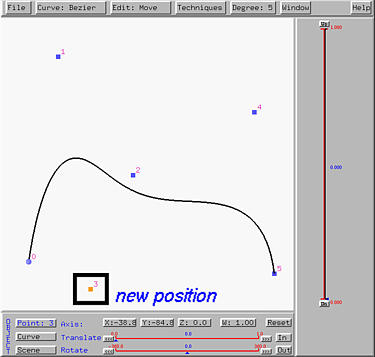
Control Polyline and Convex Hull
The Display & Options Window has a number of buttons and is
subdivided into four parts. Selecting one of these button by clicking on it
either activates or deactivates the corresponding option. If an option is
active currently, the button shows a x.
Clicking on an active (resp., inactive) button will deactivate
(resp., activate) it.
Activating Convex Hull displays the
convex hull of the control points.
Activating Control Polygon displays the
control polyline. The following shows the control polyline and convex
hull of the given control points:
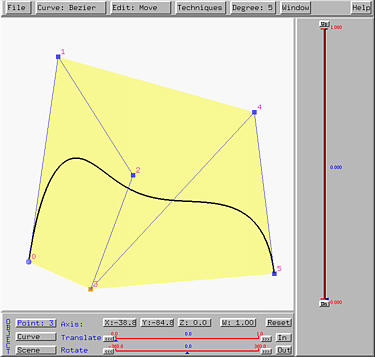
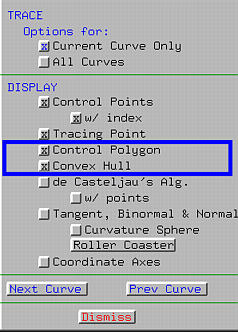
Curve Tracing
To trace the curve use the vertical slider. The range of this slider is 0
and 1. The current position of u is marked by a small triangle,
the u-indicator, and its value is shown in the middle of the
slider. As the u-indicator moves along the slider up and down,
its value is shown and a small dot, which indicates the point on the curve
corresponding to the current value of u, moves on the curve. In the
following figure, the u-indicator is moved to 0.45 (i.e.,
u = 0.45) and the corresponding point on the curve is near control
point 2.
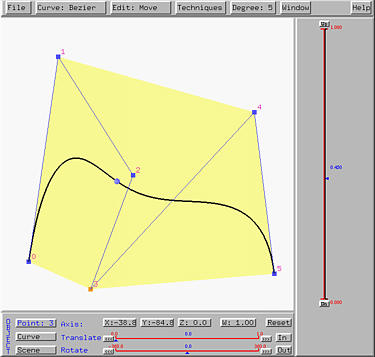
De Casteljau's Algorithm
If de Casteljau's alg. is activated,
all intermediate polylines of the computation of de Casteljau's algorithm
will be shown. As u moves, this net of polylines moves as well. The
following shows a snapshot of this feature. Note that different polylines
are shown in different colors.
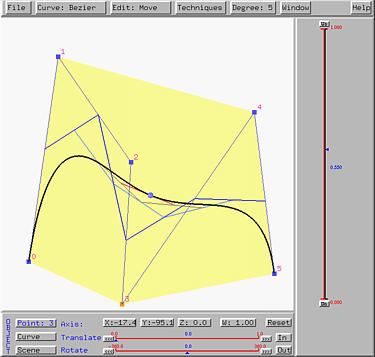
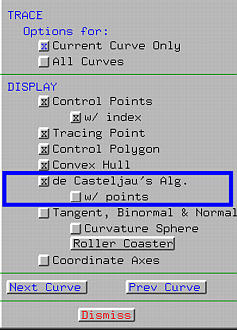
To make the polylines clearly shown, one might activate
w/ point to show the vertices of
polylines.
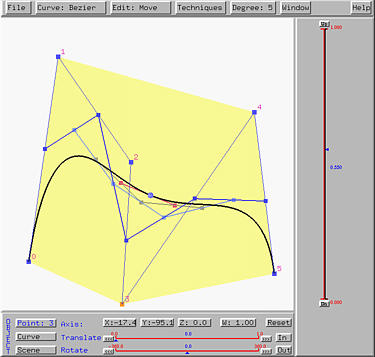
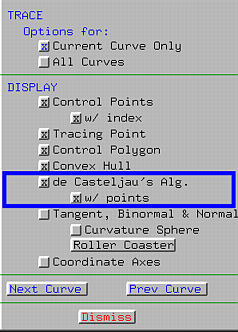
Partition of Unity
Since Bézier basis functions play an important role in
generating the curve, this program can display these basis functions and
partition of unity. To do so, choose
Window followed by
Partition of Unity. The
Partition of Unity Window appears and shows all basis functions.
To dispose this window, select the
Dismiss button at the lower left corner
of this window.
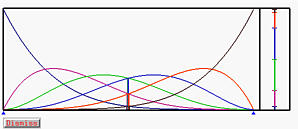
In our example, there are six control points and hence six basis
functions, one for each control point. Each of these six basis functions
are shown with a different color. As u moves by dragging the
u-indicator with the vertical slider, its position will also be
shown in this partition of unity window with a vertical bar.
At the right end of this window, values of all basis functions
at u are arranged into a vertical line segment showing the
way of partitioning of unity. As u changes, the way of
partitioning of unity changes as well. The above figure shows the way of
partitioning of unity at u = 0.5.














